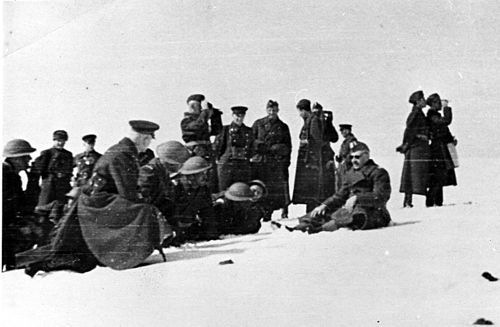
Anders' Army was the informal yet common name of thePolish Armed Forces in the East in the 1941–42 period, in recognition of its commanderWładysław Anders. The army was created in theSoviet Union but, in March 1942, based on an understanding between the British, Polish, and Soviets, it was evacuated from the Soviet Union and made its way throughIran toPalestine. There it passed under British command and provided the bulk of the units and troops of thePolish II Corps (member of thePolish Armed Forces in the West), which fought in theItalian Campaign. Anders' Army is notable for having been primarily composed of liberated POWs and forWojtek, a bear who had honorary membership.

At the start of theSoviet invasion of Poland (17 September 1939), the Soviets declared that thePolish state, previouslyinvaded by Axis forces on 1 September 1939, no longer existed, effectively breaking offPolish–Soviet relations.[1] Soviet authorities deported about 325,000 Polish citizens fromSoviet-occupied Poland to the Soviet Union in 1940–41.[2] Due to British mediation and pressure, the Soviet Union and thePolish government-in-exile (then based in London) re-established Polish–Soviet diplomatic relations in July 1941 after theGerman invasion of the Soviet Union started on 22 June 1941. TheSikorski–Mayski agreement of 30 July 1941 resulted in the Soviet Union agreeing to invalidate the territorial aspects of the pacts it had had withNazi Germany and to release tens of thousands of Polishprisoners-of-war held in Soviet camps. Pursuant to the agreement between thePolish government-in-exile and the Soviet Union, the Soviets granted "amnesty" to many Polish citizens, from whom a military force was formed. A Polish–Soviet military agreement was signed on 14 August 1941; it attempted to specify the political and operational conditions for the functioning of the Polish army on Soviet soil. Stalin agreed that this force would be subordinate to the Polish government-in-exile, while operationally being a part of the Soviet-GermanEastern Front.[3]
On 4 August 1941 the Polish prime minister and commander-in-chief, GeneralWładysław Sikorski, nominated General Władysław Anders, just released from theLubyanka prison inMoscow, as commander of the army. GeneralMichał Tokarzewski began the task of forming the army in the Soviet village ofTotskoye inOrenburg Oblast on 17 August. Anders announced his appointment and issued his first orders on 22 August.

The formation began organizing in theBuzuluk area, and recruitment began in theNKVD camps among PolishPOWs. By the end of 1941 the new Polish force had recruited 25,000 soldiers (including 1,000 officers), forming three infantry divisions:5th,6th and7th.Menachem Begin (the future leader of theZionist paramilitary groupIrgun, prime minister ofIsrael andNobel Peace Prize winner) was among those who joined. In the spring of 1942 the organizing center moved to the area ofTashkent inUzbekistan and the8th division was also formed.
The recruitment process met obstacles. Significant numbers of Polish officers were missing as a result of theKatyn massacre (1940), unknown at that time to the Poles. The Soviets did not want citizens of theSecond Polish Republic who were not ethnic Poles (such as Jews, Belarusians, Lithuanians and Ukrainians) to be eligible for recruitment. The newly established military units did not receive properlogistical support or supplies. Some administrators of Soviet camps holding the Poles interfered with the already authorized release of their Polish inmates.[citation needed]
The Soviets, coping with the deteriorating war situation, were unable to provide adequate food rations for the growing Polish army, which was sharing its limited provisions with the also growing group ofPolish civilian deportees.[4] After theAnglo-Soviet invasion of Iran (August–September 1941), Stalin agreed on 18 March 1942 to evacuate part of the Polish formation as a military force toIran, and the soldiers transferred across theCaspian Sea fromKrasnovodsk to the port ofPahlavi in Iran. Eventually all the soldiers and civilians gathered were allowed to leave the Soviet Union and to enter British-controlled territories.


More military personnel and civilians were transferred later that summer, up to the end of August, by ship and by an overland route fromAshgabat,Turkmenistan to the railhead inMashhad, Iran. Thousands of former Polish prisoners walked from the southern border of the Soviet Union to Iran. Many died in the process due to cold weather, hunger, and exhaustion. About 79,000 soldiers and 37,000 civilians – Polish citizens – left the Soviet Union.[5]
Anders' Army was transferred to the operational control of the British government, as part of the BritishMiddle East Command. The unit travelled through Iran,Iraq andPalestine, where many of its soldiers joined thePolish Second Corps, a part of thePolish Armed Forces in the West. With the corps, troops from Anders' Army fought in theItalian Campaign, including theBattle of Monte Cassino. Their contribution is commemorated in Poland in names of streets and other places.

When Anders' Army left the Soviet Union on its journey towards the Middle East, families of the soldiers and groups of Jewish children, war orphans, joined the Jewish soldiers. After arriving inTehran, Iran, the children were transferred into the hands of the emissaries who brought them to Palestine. Central in obtaining permission for Jewish groups to cross the Iraqi border – permission that had initially been denied – were individuals likePolish Red Cross worker Halina Dmochowska, and prayers were later said for her in various synagogues in Palestine.
When Anders' Army reached Palestine, of its over 4,000 Jewish soldiers, 3,000 left the army.[6]
Of the Jewish officers and men in Anders' Army who fought in the Italian campaign, 28 were killed and 62 were wounded. 136 of Anders' Jewish soldiers were decorated, including 6 Jews who received the Order of the "Virtuti Militari", the highest Polish Military Decoration for Gallantry.[7] In Italy, Jewish and ethnic Polish soldiers of Anders' Army fought alongside Jewish soldiers in British units, including theJewish Brigade of theBritish Eighth Army.[8][better source needed]
In 2006, a memorial to Anders' Army was erected in the Catholic cemetery onMount Zion inJerusalem.[9][better source needed]